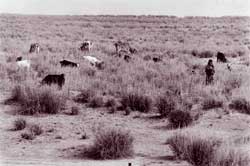The milk that ate the grass
 SCENE I: 5 am in the morning, a household in any part of India. The milkman rings the doorbell. The sleepy-eyed customer takes the daily quota of the white fluid and prepares for the day ahead. There are more than 900 million people in the country. The demand for milk is stupendous. And the country just became the largest producer of milk in the world.
SCENE I: 5 am in the morning, a household in any part of India. The milkman rings the doorbell. The sleepy-eyed customer takes the daily quota of the white fluid and prepares for the day ahead. There are more than 900 million people in the country. The demand for milk is stupendous. And the country just became the largest producer of milk in the world.
SCENE II: 5 pm in the evening, anywhere in the open country. Cows and buffaloes are returning from the pastures. Tired hooves fall on loose earth, raising an unmistakable haze, obscuring the unsatiated, scrawny animals. By grazing whatever little is left of the degraded pastures, they have just pushed India to the summit of global milk production. But how long before there is no fodder, grass or grasslands?
It is not just a question of cattle eating out of house and home. Misguided development efforts are also destroying India's grasslands. In Rajasthan, the Indira Gandhi canal has adversely affected the sewan grasslands, which have provided highly nutritious fodder for cattle in the Thar desert over the centuries.
Agriculture is also contributing to the destruction of grasslands, with the demand for cultivable land rising all the time. The scenario leaves us with a Hobson's choice: either India can increase milk production by letting cattle graze on whatever is left of its grasslands or it can grow more food crops. As the conflicting demands of people and cattle compete for land, the grasslands will continue to be razed. Across the country, village common lands that harboured grasslands earlier are being put to other uses. If these grasslands are lost, along with them will go the immense biological diversity they sustain. Plants and animals
Related Content
- Grazed and confused?: ruminating on cattle, grazing systems, methane, nitrous oxide, the soil carbon sequestration question – and what it all means for greenhouse gas emissions
- Value of forest feed to livestock in lower Himalaya
- Fodder cultivation on roadside, fallow land stressed
- Asians seek Australian alternative
- Bytes
- The 'other' food crisis
